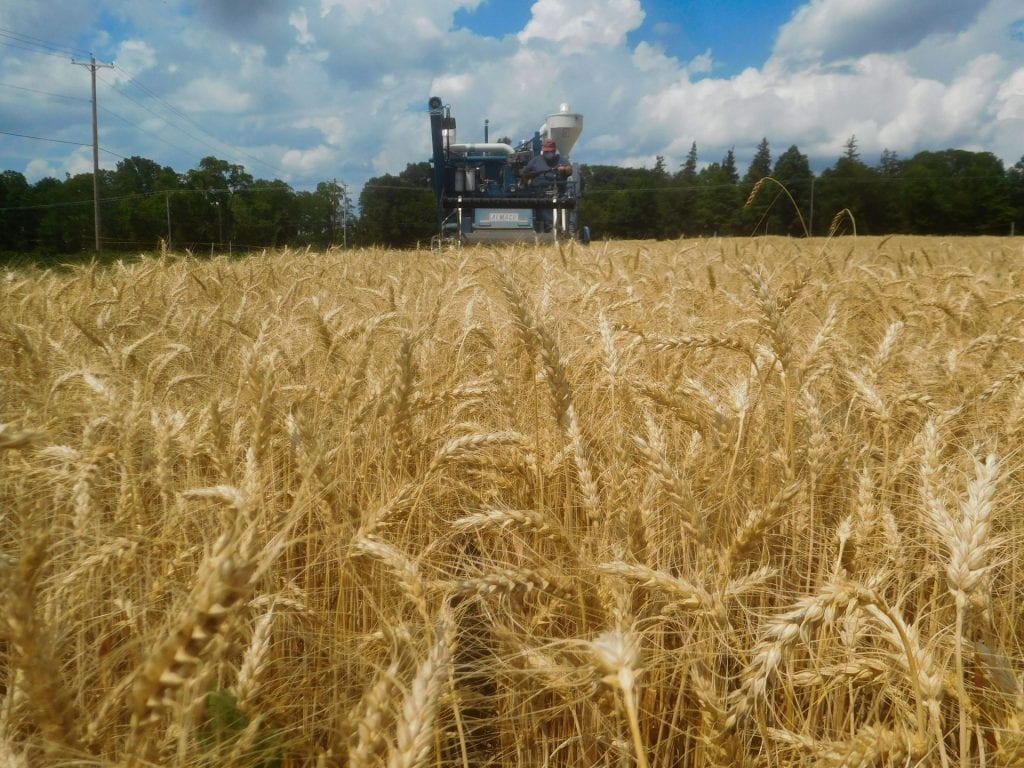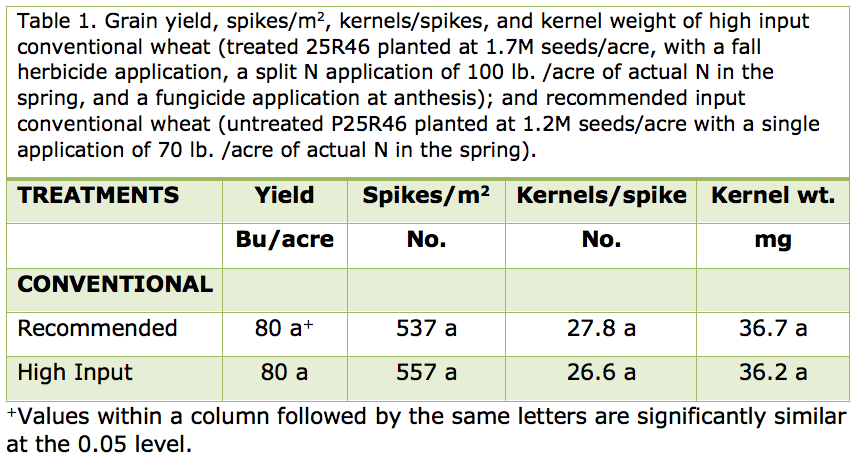by Bill Cox, Eric Sandsted, Phil Atkins, and Wes Baum

High input wheat, which is characterized by high seeding rates, a herbicide application in the fall, split-application of N in the spring (resulting in higher total N rates), and a timely spring fungicide application(s) was introduced to New York in the early 1980s. Known as intensive management of wheat in the 1980s, it was modeled after European wheat management systems, where yields were often twice that of NY wheat yields. Consultants or farmers from other countries or regions came to NY to share with NY farmers and industry personnel on how they grew wheat. Wheat prices in NY, however, plummeted to $2.80/bushel in 1985 and $2.25/bushel in 1986, which abruptly ended the push for adoption of intensive management of wheat in NY in the 1980s.
Wheat prices in NY still hovered around ~$2.80/bushel in the early 2000s and intensive or high input wheat management hadn’t been mentioned in years. Prices, however, skyrocketed to more than $6.50/bushel from 2007-2013, resulting in a resurrection of the promotion of high input wheat management. Indeed, some individuals in the NY wheat community referred to high input management as the “new way” of managing wheat. Once again, experts from Canada, England, or Michigan came to New York to instruct us on how to grow wheat. Our research from the 1980s, which included three varieties at two planting dates, reported that wheat yields were increased (10-15%) in 3 years but limited in response (2-5%) in 2 other years. More importantly, we found that intensive management of wheat did not pencil out unless prices exceeded ~$3.75/bushel, high prices back in the 1980s. Regardless, this research was totally ignored by industry and extension personnel in NY in their rush to embrace this “new way of managing wheat”.
We compared high input and recommended input management in conventional (and organic) wheat at the Aurora Research Farm in 2016, a year characterized by very dry conditions from April through June (4.61 inches total precipitation). We reported that there was no response to high input wheat in that very dry growing season https://blogs.cornell.edu/whatscroppingup/2016/09/26/organic-wheat-looked-great-but-yielded-7-5-less-than-conventional-wheat-in-20152016/). We also reported that weed densities were generally low negating a response to fall herbicide application, that the extra N applied to high input wheat did not increase spike number nor kernel number/spike, and that the fungicide application did not increase kernel weight (https://blogs.cornell.edu/whatscroppingup/2016/09/29/wheat-does-not-respond-to-high-inputs-at-the-aurora-research-farm-in-the-dry-2016-growing-season/). We attributed the lack of response to high input wheat in that year to the very dry growing conditions.
We repeated the study again this year and provided a detailed description of the inputs and their timing in high input and recommended input wheat management in a previous 2018 article (https://blogs.cornell.edu/whatscroppingup/2018/07/23/another-shocker-organic-wheat-with-high-inputs-86-buacre-vs-79-buacre-for-conventional-wheat-both-yield-80-bushelsacre-with-recommended-inputs/). Briefly, high input wheat was seeded at 1.7M seeds/acre in late September, received an herbicide application (Harmony extra) in late October, a split-application of N in the spring (~50 lbs. /acre of actual N in late March and another ~50 lbs. /acre of actual N in late April), and a timely fungicide application (Prosaro) at the end of May at anthesis. In contrast, recommended input wheat was seeded at 1.2M seeds/acre and received a single 70 lb. /acre N application in late March. That was it-essentially a plant, top-dress, and harvest management system.
We sub-sampled 1.52 m2 areas (8 rows by 1 meter) in two locations of all wheat plots to determine yield components of all treatments on July 8, the day before harvest. The sub-samples were first weighed, and then the spikes were counted. The spikes were then threshed so all the kernels (~20,000 kernels/sample) could be counted with a seed counter before being weighed. From the sub-sample data, we determined the number of spikes/m2 and kernels/spike, as well as individual kernel weight of all the treatments.
We reported in the above-cited 2018 article that once again there was no response to high input conventional wheat management in 2018 with recommended management yielding 80 bushels/acre and high input management yielding 79 bushels/acre. Let’s examine the yield component response to determine why there was once again a lack of response to high input management in conventional wheat. Table 1 indicates that there was no statistical response in spikes/m2, kernels/spike, or in kernel weight of individual kernels to the additional inputs in high input wheat. As in 2016, the relatively dry weather conditions in April and May (4.87 inches of precipitation total) probably resulted in no leaching or denitrification of the applied N (70 lbs. /acre) in late March in the recommended input management treatment. The lack of response to an additional 30 lbs. /acre of N is especially interesting in 2018 because the record cold temperature in April (coldest April ever at the Aurora Research Farm and most of upstate NY) resulted in limited if any mineralization of organic N. Consequently, the 70 lb. /acre application of N in late March (as well as the recommended seeding rate of 1.2M seeds/acre) provided adequate N for optimum tillering and subsequent spike development. Thus, the recommended input management treatment, despite being planted at 500,000 fewer seeds/acre and receiving 30 lbs. /acre of less N, had similar spike numbers as the high input treatment.
The single 70 lb. /acre application of N also provided adequate N for optimum kernel/spike development as indicated by the statistically similar number of kernels/spike between treatments. The potential number of flowers or florets in wheat is determined at the double ridge stage (sometime around the end of tillering or the end of April), successful fertilization of the florets occurs during stem elongation or during May, and successful kernel set and retention, thus final kernel number, is determined during anthesis and in the 1-week period after anthesis. Nitrogen and soil water availability (as well as genetics, tiller number, and or light) are major drivers in determining kernel number. Again, the statistically similar number of kernels/spike between high input and recommended input management indicates adequate N in the recommended treatment.
Finally, the dry June conditions (1.63 inches of precipitation) evidently limited disease development, as indicated by the similar kernel weights between the high input and recommended input management treatments. Obviously, a fungicide application was not required on wheat during the dry spring of 2018. The yield component data is quite robust. If you do the math, you will find that the estimated yield from the recommended input subsamples came in at 81.6 bushels/acre and the estimated yield from the high input subsamples came in at 79.9 bushels/acre. You can’t get much more precise than that.
So now we have compared high input vs. recommended input wheat management 7 times (5 times in the 1980s, and again in 2016 and in 2018). We only observed a yield response in 3 of 7 years. We only observed an economic yield response in 1 of 7 years. I realize that all the data is specific to the Aurora Research Farm where yields are not as high as they are in western NY. But I would think that data from central NY would be more relevant than data from SW Ontario, Kentucky, or from Michigan? Especially replicated data with lots of supporting measurement to quantify responses.
Certainly, in some years (wet spring conditions), a split-application of additional N in tandem with a timely fungicide application around anthesis would certainly be warranted. But to accept carte blanche the “new way” of managing wheat is not a good management strategy unless you are totally risk-averse. I would recommend managing wheat like you manage corn. If it is a wet spring and you apply most or all your N to corn up-front, you need to come back with a side-dress application of additional N. Same thing with wheat. If you put all your N on in late March or early April and April is very wet, an additional 30 to 40 lb./acre N top-dress application in late April would certainly be warranted. Likewise, with a fungicide application. If May is wet and disease is prevalent and there is a high likelihood of head scab development, a fungicide application is a must. But as in corn, there is no need to apply a fungicide, if disease incidence is low and there is a low probability of disease development in the near future.
Spring weather conditions vary greatly from year to year. At the Aurora Research Farm over the last 5 years, April has been exceedingly wet (6.14 inches in 2017) and exceedingly dry (1.87 inches in 2018); May has been exceedingly wet (~5.50 inches in 2015 and 2017) and exceedingly dry (~2.0 inches in 2016 and 2018); and June has been exceedingly wet (8.0 inches in 2015) and exceedingly dry (0.74 inches in 2016 and 1.63 inches in 2018). I would recommend managing wheat in the spring according to weather conditions. First, apply the recommended N rate (60-70 lbs. /acre of actual N) in late March or early April. But if April turns wet, I would suggest applying an additional 30-40 lbs. N/acre as soon as you can get on the field. Likewise, with disease management. If May turns wet, scout the fields frequently. If disease development is prevalent and especially if there is a high probability that head scab will develop once wheat heads out, I would suggest a timely fungicide application (anthesis stage). But if conditions have been dry and are predicted to stay dry, I suggest saving yourself some money.


